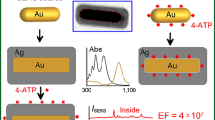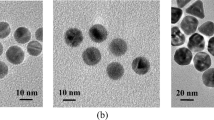Abstract
Surface-enhanced Raman scattering (SERS) tags show ultrasensitivity and multiplexing abilities due to strong and characteristic Raman signals and therefore can be utilized as optical labeling agents similar to fluorescent dyes and quantum dots for biosensing and bioimaging. However, SERS tags have the difficulty to realize quantitative analysis due to the uniformity and reproducibility issue. In this work, we have reported on a new type of SERS tag called Au rod-in-shell (RIS) gap-enhanced Raman tag (GERT). With the high-resolution transmission electron microscopy (TEM) and optical absorbance measurements, we have demonstrated the subnanometer sized gap junctions inside the RIS GERTs. SERS measurements and FDTD calculations show that the core–shell subnanometer gap geometry in the RIS GERTs not only generates strong SERS hot spots but also isolates SERS hot spots by Au shells to avoid the influence when the particle aggregates form, therefore showing better SERS uniformity and stronger SERS intensity than normal Au nanorods. Those RIS NPs exhibit great potential as the labeling agents for SERS-based bioimaging and biosensing applications.





Similar content being viewed by others
References
Duan H, Fernández-Domínguez AI, Bosman M, Maier SA, Yang JK (2012) Nanoplasmonics: classical down to the nanometer scale. Nano Lett 12:1683–1689
Gandra N, Singamaneni S (2013) Bilayered Raman-intense gold nanostructures with hidden tags (BRIGHTs) for high-resolution bioimaging. Adv Mater 25:1022–1027
Gandra N, Portz C, Singamaneni S (2014) Multifunctional plasmonic nanorattles for spectrum-guided locoregional therapy. Adv Mater 26:424–429
González E, Arbiol J, Puntes VF (2011) Carving at the nanoscale: sequential galvanic exchange and kirkendall growth at room temperature. Science 334:1377–1380
Hong S, Acapulco JA Jr, Jang HY, Park S (2014) Au nanodisk-core multishell nanoparticles: synthetic method for controlling number of shells and intershell distance. Chem Mater 26:3618–3623
Johnson PB, Christy R-W (1972) Optical constants of the noble metals. Phys Rev B 6:4370–4379
Kang JW, So PT, Dasari RR, Lim D-K (2015) High resolution live cell Raman imaging using subcellular organelle-targeting SERS-sensitive gold nanoparticles with highly narrow intra-nanogap. Nano Lett 15:1766–1772
Kern J et al (2012) Atomic-scale confinement of resonant optical fields. Nano Lett 12:5504–5509
Khlebtsov BN, Ithanadeev VA, Ye J, Sukhorukov GB, Khlebtsov NG (2014) Overgrowth of gold nanorods by using a binary surfactant mixture. Langmuir 30:1696–1703
Khlebtsov BN, Liu Z, Ye J, Khlebtsov NG (2015) Au@ Ag core/shell cuboids and dumbbells: optical properties and SERS response. J Quant Spectrosc Radiat Transf 167:64–75
Lim D-K, Jeon K-S, Hwang J-H, Kim H, Kwon S, Suh YD, Nam J-M (2011) Highly uniform and reproducible surface-enhanced Raman scattering from DNA-tailorable nanoparticles with 1-nm interior gap. Nat Nanotechnol 6:452–460
Lin L, Gu H, Ye J (2015a) Plasmonic multi-shell nanomatryoshka particles as highly tunable SERS tags with built-in reporters. Chem Commun 51:17740–17743
Lin L et al (2015b) Nanooptics of plasmonic nanomatryoshkas: shrinking the size of a core-shell junction to subnanometer. Nano Lett 15:6419–6428
Mazzucco S et al (2012) Ultralocal modification of surface plasmons properties in silver nanocubes. Nano Lett 12:1288–1294
Oh J-W, Lim D-K, Kim G-H, Suh YD, Nam J-M (2014) Thiolated DNA-based chemistry and control in the structure and optical properties of plasmonic nanoparticles with ultrasmall interior nanogap. J Am Chem Soc 136:14052–14059
Savage KJ, Hawkeye MM, Esteban R, Borisov AG, Aizpurua J, Baumberg JJ (2012) Revealing the quantum regime in tunnelling plasmonics. Nature 491:574–577
Scholl JA, García-Etxarri A, Koh AL, Dionne JA (2013) Observation of quantum tunneling between two plasmonic nanoparticles. Nano Lett 13:564–569
Tan SF, Wu L, Yang JK, Bai P, Bosman M, Nijhuis CA (2014) Quantum plasmon resonances controlled by molecular tunnel junctions. Science 343:1496–1499
Tsai M-F, Chang S-HG, Cheng F-Y, Shanmugam V, Cheng Y-S, Su C-H, Yeh C-S (2013) Au nanorod design as light-absorber in the first and second biological near-infrared windows for in vivo photothermal therapy. ACS Nano 7:5330–5342
Wang S, Xu H, Ye J (2014) Plasmonic rod-in-shell nanoparticles for photothermal therapy. Phys Chem Chem Phys 16:12275–12281
Wen F, Ye J, Liu N, Van Dorpe P, Nordlander P, Halas NJ (2012) Plasmon transmutation: inducing new modes in nanoclusters by addling dielectric nanoparticles. Nano Lett 12:5020–5026
Xia X, Wang Y, Ruditskiy A, Xia Y (2013) 25th anniversary article: galvanic Replacement: a simple and versatile route to hollow nanostructures with tunable and well-controlled properties. Adv Mater 25:6313–6333
Xiong W, Mazid R, Yap LW, Li X, Cheng W (2014) Plasmonic caged gold nanorods for near-infrared light controlled drug delivery. Nanoscale 6:14388–14393
Yavuz MS et al (2009) Gold nanocages covered by smart polymers for controlled release with near-infrared light. Nat Mater 8:935–939
Ye J, Shioi M, Lodewijks K, Lagae L, Kawamura T, Van Dorpe P (2010) Tuning plasmonic interaction between gold nanorings and a gold film for surface enhanced Raman scattering. Appl Phys Lett 97:163106–163108
Ye X, Zheng C, Chen J, Gao Y, Murray CB (2013) Using binary surfactant mixtures to simultaneously improve the dimensional tunability and monodispersity in the seeded growth of gold nanorods. Nano Lett 13:765–771
Ye X, Shi H, He X, Wang K, Li D, Qiu P (2014) Gold nanorod-seeded synthesis of Au@ Ag/Au nanospheres with broad and intense near-infrared absorption for photothermal cancer therapy. J Mater Chem B 2:3667–3673
Zhao B et al (2014) Gold nanostructures encoded by non-fluorescent small molecules in polyA-mediated nanogaps as universal SERS nanotags for recognizing various bioactive molecules. Chem Sci 5:4460–4466
Acknowledgments
We gratefully acknowledge the National Natural Science Foundation of China (No. 21375087 and 81571763) and Shanghai Jiao Tong University (No. YG2014MS53 and SJTU-KUL Bilateral Program) for their financial support.
Author information
Authors and Affiliations
Corresponding authors
Additional information
Shanshan Wang and Zhonghui Liu have equally contributed to this work.
Rights and permissions
About this article
Cite this article
Wang, S., Liu, Z., Bartic, C. et al. Improving SERS uniformity by isolating hot spots in gold rod-in-shell nanoparticles. J Nanopart Res 18, 246 (2016). https://doi.org/10.1007/s11051-016-3546-3
Received:
Accepted:
Published:
DOI: https://doi.org/10.1007/s11051-016-3546-3




